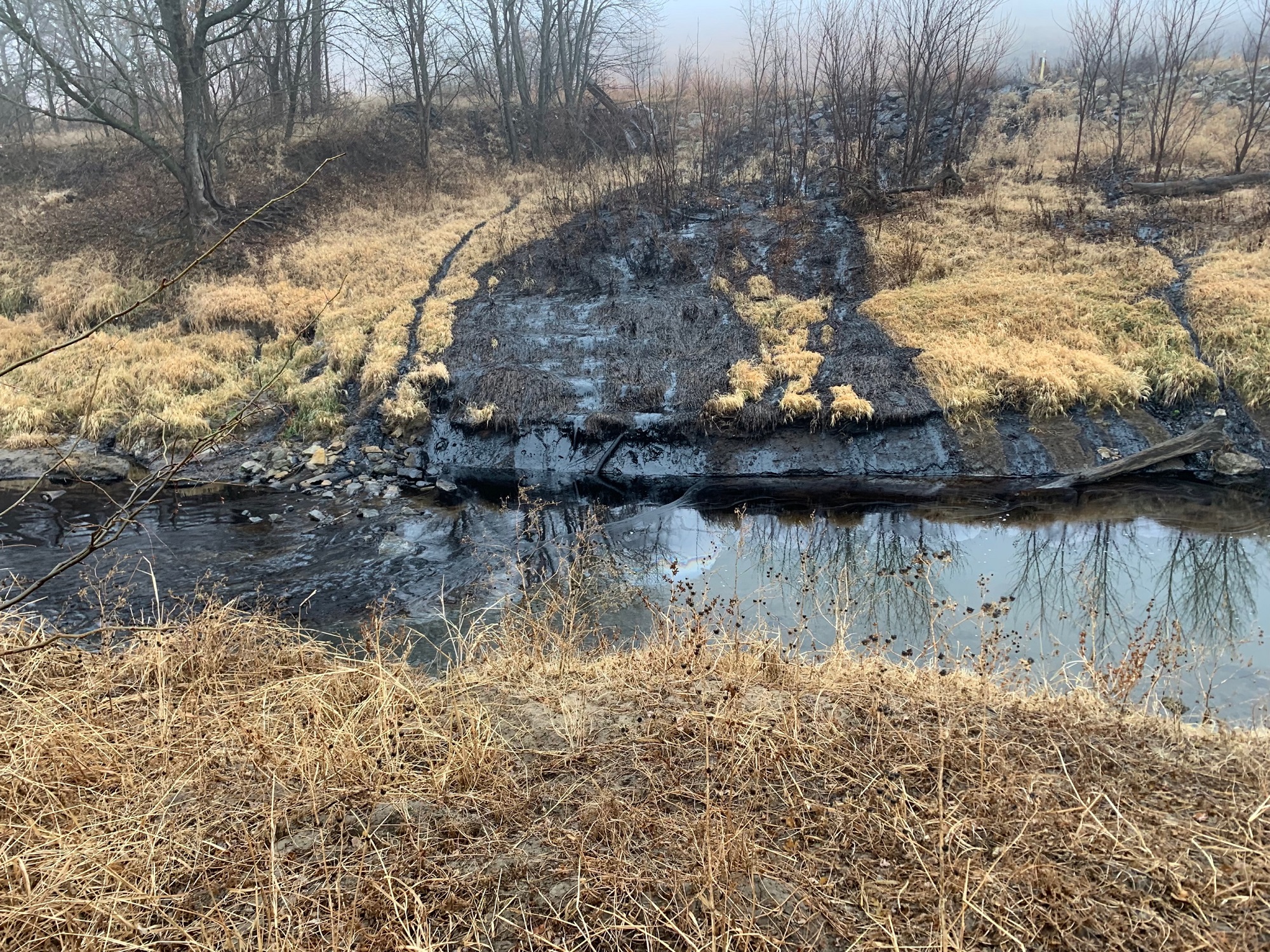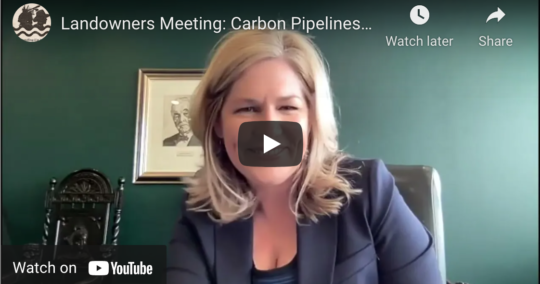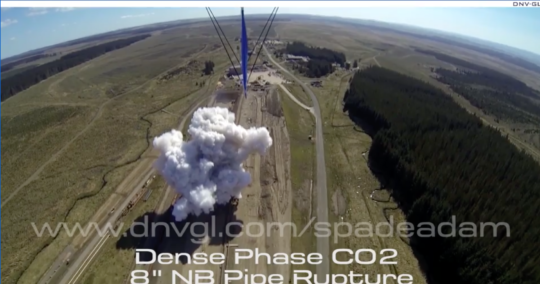

TC Energy’s original Keystone oil pipeline recorded its 22nd spill on Dec. 7, 2022.
According to Reuters, “An emergency shutdown and response was initiated at about 9 p.m. CT on Dec. 7 after alarms and a pressure drop in the system, the company said in a release, adding booms were deployed to control downstream migration of the release. “The system remains shut down as our crews actively respond and work to contain and recover the oil,” the release said. The company was not immediately available to comment on the volume of the release.”
Bold Nebraska founder Jane Kleeb issued this statement:
“As we wait to hear how much tarsands and toxic chemicals like benzene have polluted our water from TC Energy’s Keystone 1 pipeline, it is critical to note our state and counties need better laws on the books for pipelines. Thankfully, landowners and Tribal Nations came together to stop the larger Keystone XL pipeline from cutting through sensitive areas of the Ogallala Aquifer and the Niobrara River. Now is the time to get stronger laws on the books to protect our state’s assets — the land, the water and the people,” said Bold Nebraska founder Jane Kleeb.
Bold Nebraska has documented at least 22 spills on TC Energy’s (formerly TransCanada) original “Keystone 1” pipeline since 2010. See: Keystone Pipeline Spill History.
- #22: Dec. 7, 2022: TC Energy shut down its Keystone pipeline after detecting a leak of an unknown volume into a creek about 20 miles south of Steele City, NE. “An emergency shutdown and response was initiated at about 9 p.m. CT on Dec. 7 after alarms and a pressure drop in the system, the company said in a release, adding booms were deployed to control downstream migration of the release.”
- November 5, 2019: PHMSA issues Corrective Action Order to TransCanada re: Oct. 30 spill.
- #21: October 31, 2019: TransCanada’s (“TC Energy”) Keystone pipeline leaked at least 380,000 gallons of tarsands oil and toxic diluents that affected wetlands in northeastern North Dakota. No cause has yet been established.
- #20: February 6, 2019: Keystone pipeline spills 1,800 gallons in St. Charles County, Missouri. After metallurgical analysis of the spill’s cause: “The composite wrap was inadequately designed for the metal loss feature it was to protect, as the applicator’s interpretation of the feature as mechanical damage led to fewer wraps than corrosion given the naming convention used in the composite vendor’s software. Feature direct examination concluded blunt metal loss with no evidence of sharp edges or stress concentrators, and the feature root cause analysis determined the accelerated rate of corrosion was primarily caused by stray direct current interference and was subsequently repaired. The RCFA indicated the primary cause of the leak was a through-wall crack that exhibited signs of fatigue, initiated from localized stress concentrations in the irregular pitted surface of the repaired metal loss feature.” Of note: A 2015 investigation in the same county found Keystone pipe there had “suffered from corrosion so severe that it was worn through 95 percent in some places after being in service for less than two years. In one spot, inspectors found the pipeline was down to a metal layer just one third the thickness of a dime.”
- #19: February 20, 2018: Keystone pipeline spills 15 gallons from a Pump Station in Steele City, Nebraska, blamed on “a leaking float control valve.”
- November 28, 2017: PHMSA issues Corrective Action Order to TransCanada re: Nov. 17 spill.
- #18: November 16, 2017: Keystone pipeline leaks 407,000 gallons on farmland near Amherst, South Dakota. Spill was originally underreported as 210,000 gallons, and was attributed to “the installation of a weight upon its construction in 2008” that is “used to keep pipelines in place and reduce the risk of damage to the line if water levels rise,” but instead “caused mechanical damage to the company’s corrosion-resistant coating, leading to the rupture.”
- #17: December 27, 2016: Keystone pipeline spilled 10 gallons at a Pump Station near Tina, Missouri.
- May 2016: TransCanada announces plans to “dig up and replace sections of its Keystone pipeline found to not meet federal strength standards.”
- April 9, 2016: PHMSA issues Corrective Action Order to TransCanada re: the April 2 spill.
- #16: April 2, 2016: Keystone pipeline leaks 16,800 gallons in Hutchinson County, South Dakota, cause found to be a “faulty girth weld,” the point of a transition weld connecting smaller and larger pipe together. TransCanada whistleblower and former company engineer Evan Vokes has repeatedly sounded the alarm about TransCanada’s use of transition welds.
- April 2015: A Freedom of Information Act (FOIA) request made to PHMSA in 2013 returns documents uncovering an alarming rate of corrosion on TransCanada’s Keystone pipeline: “a section of the pipeline’s wall had corroded 95%, leaving it paper-thin in one area (one-third the thickness of a dime) and dangerously thin in three other places.” PHMSA did not disclose a cause for the corrosion at the time, saying it “might impact an ongoing compliance review the agency is conducting of TransCanada.”
- #15: July 24, 2014: Keystone pipeline leaks 30 gallons in Nederland, Texas.
- #14: March 7, 2013: Keystone pipeline leaks 15 gallons near Potwin, Kansas.
- June 28, 2011: PHMSA issues Corrective Action Order to TransCanada re: May 7 & May 29 leaks.
- #13: May 29, 2011: Keystone pipeline leaks 14,000 gallons after “valve failure” at Severance Pump Station in southeastern North Dakota, which saw “a 1/2-inch diameter nipple at the pressure transmitter manifold. Preliminary metallurgical testing provided by the Respondent of this nipple indicates cyclical fatigue.”
- #12 May 25, 2011: Keystone pipeline leaks unknown volume at Roswell Pump Station due to a “transmitter fitting leak” that “failed due to cyclical fatigue.” (This spill is only reported in the context of a separate Corrective Action Order related to the May 7th 16,800-gallon Keystone spill where the same cause “cyclical fatigue” was reported.)
- #11: May 7, 2011: Keystone pipeline leaks 16,800 gallons (400 barrels) at Ludden Pump Station onto private land in North Dakota. The spill spewed up 60 feet in the air “like a geyser” and was discovered by local rancher smelling it on his land; he’s still dealing with TransCanada over cleanup. The spill was caused by “a threaded connection on small diameter station piping at a 1-inch x 3/4-inch swaged nipple. Respondent performed metallurgical analysis of the nipple and identified the presence of cracks at the root of the thread likely as a result of over-torque during installation. Respondent determined that the cyclic bending stress fatigue due to normal operational vibration propagated the cracks to failure.”
- #10: March 16, 2011: Keystone pipeline leaks 126 gallons at Seneca Pump Station in Nemaha County, Kansas, after “a seal on the #4 unit failed releasing crude oil onto the piping, the pump and the ground.”
- #9: March 8, 2011: Keystone pipeline leaks 5 gallons from Ludden Pump Station near Brampton, North Dakota “due to equipment failure on a seal on a main pump.”
- #8: February 23, 2011: Keystone pipeline leaks 10 gallons from Rock Pump Station near Udall, Kansas “on a drain valve line possibly due to a leaky fitting.”
- #7: February 3, 2011: Keystone pipeline leaks 15 gallons “from a vapor separator which caused an overflow” at a Pump Station near Cushing, Oklahoma.
- #6: January 31, 2011: Keystone pipeline leaks 10 gallons at a Pump Station near Turney, Missouri after a “seal on a pump failed.”
- #5: January 5, 2011: Keystone pipeline leaks 10 gallons at a Pump Station near Andover, South Dakota. Spill blamed on “faulty seal.”
- #4: August 19, 2010: Keystone pipeline leaks 10 gallons near Hartington, Nebraska after “a check valve on a pressure transmitter located on the suction side of a line pump stuck open.”
- #3: August 10, 2010: Keystone pipeline leaks 5 gallons near Freeman, South Dakota, “cause unknown.”
- #2: June 23, 2010: Keystone pipeline leaks 20 gallons at Roswell Pump Station in North Dakota blamed on “equipment failure.”
- #1: May 21, 2010: Keystone pipeline leaks 2 gallons at Carpenter Pump Station in Clark County, South Dakota. Spill is blamed on a “leaking valve body.”



